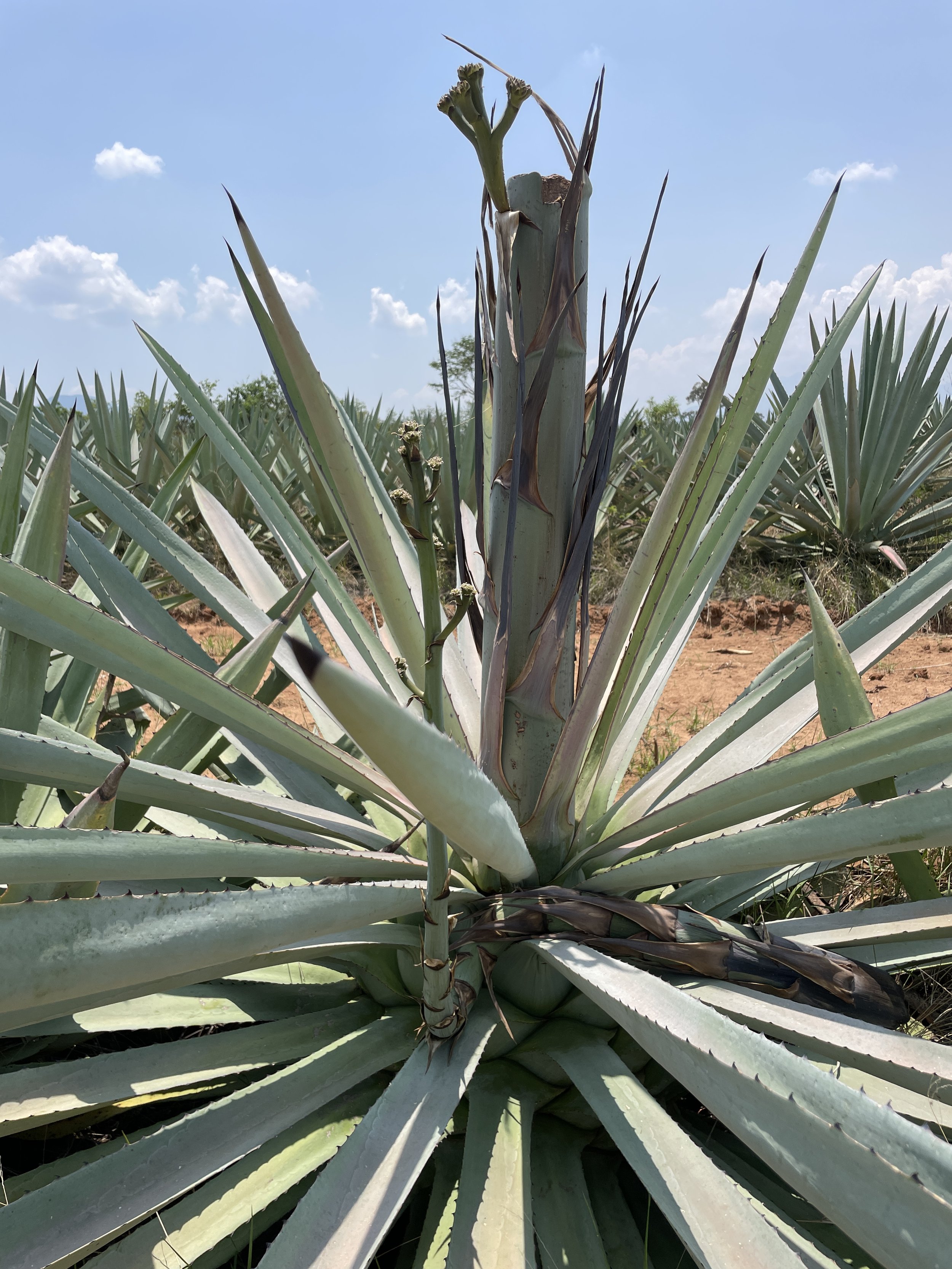An Ode to Espadín
Each release of NETA Espadín Capón is a singular production that represents a particular moment in time and space, reflecting the terruño and gastronomic traditions of the region and the hand of its maker. In the village of Logoche, San Luis Amatlán, Oaxaca, these batches are made in quantities of about 200-1,200 liters at a time and typically range from 46% to 52% ALC, corresponding with the producers’ own preferences and production capacity. They aren’t overly smokey, but instead smell and taste of perfectly caramelized agave, sweet with notes further dictated by the care and multitude of environmental and human factors behind their cultivation, harvest, fermentation, distillation, and final composition. The limestone-dominant soils, mineral-rich water, and skill of the palenqueros in Logoche are all contributing aspects behind the quality of the Espadín selected and bottled by NETA, but it is the community organization, care, and intention behind their production that bring it all to life. A well-crafted Espadín from Logoche can hold its own against anything in a well-curated back bar or home liquor cabinet.
Despite its modern fame and almost ubiquitous mass cultivation around the state, it is important to note that the cultivated Agave angustifolia variety commonly known in most of Oaxaca as “Espadín”, is likely not native to the region. There is some talk of these plants arriving to parts of the state in the 1930’s, but most references date the popularization of Espadín to Matatlán-based business interests and later through governmental programs, spreading relatively slowly throughout the state from the 1950’s into the 2000’s. Recent studies have confirmed that Jalisco is home to the greatest diversity of both wild and cultivated Agave angustifolia, suggesting that this species originates in the northwestern Pacific regions of Mexico. [1] Additional studies have shown that Espadín is in fact almost genetically identical to both the Blue Weber agave from Jalisco that is famously used in Tequila production, as well as a grouping of wild Agave rhodacantha from Sonora. Botanists have now concluded that “because of their close relationship with A. tequilana, and the results from this and other studies, the domesticated plants called ‘Espadín’ could be considered as a cultivar of A. tequilana.”[2]
In conversations with dozens of producers and growers from around Miahuatlán, they have consistently reported that Espadín was not introduced into this southern region until the 1970’s- a period that coincided with the arrival of tequileros and big business that came looking for cheap agave in mass quantity during a time of low supply and high demand in Jalisco. This overlapped with a moment when prices for both Oaxacan mezcal and agave had hit rock bottom, so when Jalisco based buyers began to haul out acre after acre of genetically diverse fields of ripe agave, many farmers chose to replant with the new, fast-maturing, high-yielding, and easy to reproduce Espadín. Over the course of generations, these magueys have adapted to the very different soil types and diverse climates around the state of Oaxaca allowing for some drastically distinct expressions. It is precisely for this reason that a well-made Espadín can serve as a great lens in which to understand the different territories of Oaxaca, and the very particular flavors that come from not only each micro-region, but also each palenque. As such, a spirit made from Espadín should not be overlooked or discounted because of its widely cultivated status, but rather, treated as a reflection of the craft and skill of its maker and its place of origin.
Unfortunately, a lot of agave fans can be dismissive of mezcal made from Espadín (Agave angustifolia var.) and seek out batches made with other species of cultivated and wild agave, looking for more expressive flavor profiles. Most easily accessible and commercially available mezcal is made with Espadín, and quite frankly, it isn’t that great. Now that the gimmicky bottle with a worm at the bottom has become somewhat a memory of the past, most people´s exposure to mezcal from Espadín outside of the villages of production comes through cocktails, or a watered-down smoke bomb perhaps served with some orange slices. Market demands, perceived or otherwise, have created a race to the bottom to dominate well-space in bars and occupy retail shelves with cheap bottles priced between $25-$40. Most of this type of mezcal is introduced through large brands deeply embedded in the political and business landscapes of Mexico, and increasingly, through multinational behemoths with a bottom line concerned only with increasing their market share and profits for their investors. As such, there is no real concern to produce a product that is reflective of the quality and traditions from which it originates, but rather a desire for a standardized SKU that can hit certain price points and reach consumers with as little resistance as possible. In this context, business interests have implemented practices of standardization and homogeneity behind a marketing idea that reduces a profound legacy and bio-cultural product to the status of a simple ingredient.
Espadín capón
Comparatively, this type of mezcal might still be more interesting on the palate than most commercial Tequila, Vodka, or Gin, but these homogenized and low ABV Espadín productions are a long way from what the palenqueros themselves drink, and far removed from the genuinely artisanal spirit that is held in such high regard in these producing regions. Apart from some lucky few, most folks simply haven’t had the opportunity to experience just how spectacular these spirits can be. In Logoche, they are exceptional. The town was initially founded at the turn of the 20th century by a handful of families from nearby villages who sought an isolated and relatively safe space to clandestinely produce mezcal during times of strict governmental regulation. The first license for legal production was procured in 1976 by don Nicolás García Vásquez, whose children and grandchildren carry the torch today.
Logoche is now internationally known for the remarkable quality and distinctive characteristics of the mezcal that is made in this community of just over 100 people. Farmer-producers work with around thirty different types of agaves, but if you ask anyone in town what their favorite mezcal is, Espadín is always in the top three.
The Espadín batches selected and bottled by NETA are all made with fully mature and capón agave, a term that refers to the cutting and literal castration of the quiote (flowering stalk), generally six months to two years prior to its eventual harvest. This action further concentrates the sugars of the plant which continues to grow an additional 10-15% in size and weight. Importantly, this results not only in greater yields, but the development of very particular and robust flavors and aromas that cannot be finessed with agave harvested in lesser states of maturation. The harvest itself must take place during the days surrounding a full moon, as dictated by age-old agrarian practices. While concepts of authenticity and tradition can be problematic as culture is never stagnant, these two fundamental steps in the harvest are critical prerequisites set forth by generations of agave spirit producers throughout Mexico.
These practices are evident within the depth and complexity of the aromas, flavors, and texture of the spirit, and with experience are detectable to the senses. A third signifier of importance, one which is empirically visible in the final product is the presence of a cordón cerrado, a Oaxacan term that relates to the closed panel of bubbles that are formed when the liquid is agitated. Observing the size and duration of the bubbles is most principally related the ABV and amount of alcohol present in the liquid but can also be indictive of levels of viscosity that do correlate with objective quality. Somewhere between 80-90% of mezcal available in commercial markets is made from Espadín, most of it with water added, and commonly bottled around 40% ABV, a proof so low that this liquid would literally not be identified as “mezcal” by craft producers, but rather as ordinario or shishe, the low wines that would require another round of distillation. Bureaucratic definitions aside, it is the presence of a cordón cerrado that is the hallmark signature of what can be called a mezcal in Logoche and throughout the region.
In working with an ever-growing roster of family producers in Logoche since 2013, we periodically release different batches of Espadín Capón made by different producers under the NETA label. The names accredited on the back label of the bottle do change, but the quality never waivers. As nothing is standardized or homogenized, the flavors do vary from producer to producer and batch to batch, but we find this inherent trait of genuine artisanal production a positive and not a detractor. This goes against the grain of conventional commercialization and as such, it is challenging to navigate traditional avenues of distribution and sales. It is by maintaining relationships on the ground in Miahuatlán and in partnering with importers and disturbers who understand these dynamics that are we able to share these exceptional spirits with the world.
[1] https://www.ncbi.nlm.nih.gov/pmc/articles/PMC9460824/#B25-plants-11-02274
[2] Lugo-Rivera, Miguel, et al. Taxonomic implications of the morphological and genetic variation of cultivated and domesticated populations of the Agave angustifolia complex (Agavoideae, Asparagaceae) in Oaxaca, Mexico. 2018.


